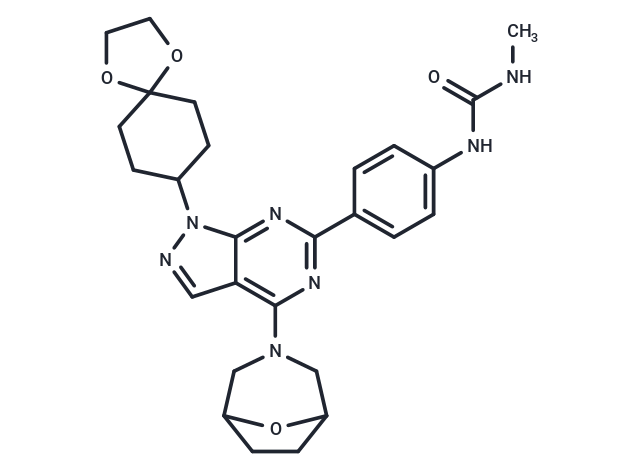Shopping Cart
- Remove All
 Your shopping cart is currently empty
Your shopping cart is currently empty

WYE-125132 (WYE-132 (WYE-125132)) is a highly potent, ATP-competitive mTOR inhibitor with IC50 of 0.19 nM; highly selective for mTOR versus PI3Ks or PI3K-related kinases hSMG1 and ATR.

| Pack Size | Price | Availability | Quantity |
|---|---|---|---|
| 1 mg | $39 | In Stock | |
| 5 mg | $77 | In Stock | |
| 10 mg | $118 | In Stock | |
| 25 mg | $198 | In Stock | |
| 50 mg | $293 | In Stock | |
| 100 mg | $433 | In Stock | |
| 1 mL x 10 mM (in DMSO) | $88 | In Stock |
| Description | WYE-125132 (WYE-132 (WYE-125132)) is a highly potent, ATP-competitive mTOR inhibitor with IC50 of 0.19 nM; highly selective for mTOR versus PI3Ks or PI3K-related kinases hSMG1 and ATR. |
| Targets&IC50 | mTOR:0.19 nM |
| In vitro | WYE-125132 potently and ATP-competitively inhibits recombinant mTOR kinase with IC50 of 0.19 nM and also shows the high selectivity over various PI3Ks and a panel of 230 protein kinases. [1] In vitro, WYE-125132 exhibits a significant anti-proliferative activity against a panel of tumor cell lines with IC50 ranging from 2 nM (LNCap) to 380 nM (HTC116). Besides, WYE-125132 also causes cell cycle progression, induction of apoptosis, and inhibition of protein synthesis and cell size. [1] WYE-125132 results in a significant reduction in the synthesis of pre-tRNALeu by 72%, 80%, and 53% in actively proliferating cells of MG63, MDA361, and HEK293, respectively by inhibiting mTORC1. Moreover, WYE-125132 is also found to induce the dephosphorylation of Maf1 (negative regulator of Pol III transcription) and its accumulation in the nucleus. [2] |
| In vivo | WYE-125132 (5 mg/kg p.o.) produces significant antitumor activity and causes dose-dependent tumor growth delay in the PI3K/mTOR- and HER2-hyperactive MDA361 tumor model. In addition, WYE-125132 also shows potent antitumor efficacy in the PTEN-null glioma U87 mg, non-small cell lung cancer H1975 and A549 models. [1] |
| Kinase Assay | Kinase assays: mTOR enzyme assays via dissociation-enhanced lanthanide fluorescent immunoassay (DELFIA), ATP matrix assays, and mTOR immune-complex kinase assays are performed as follows. The endogenous TOR of LNCap cell lysate is immunoprecipitated by anti-FRAP/TOR (N-19). Cell lysate (1.0 mg) is mixed with 4 μg antibody coupled to protein-G/A agarose in 1 mL lysis buffer. The immune-complexes are washed sequentially with lysis buffer, lysis buffer plus 500 mM KCl, and kinase buffer wash. The immune-complexes are subjected to kinase reaction for 30 minutes at 30 °C in a final volume of 50 μL containing 10 mM Hepes (pH 7.4), 50 mM NaCl, 50 mM β-glycerophosphate, and 0.5 μM microcystin LR, 1 mM DTT, 10 mM MnCl2, 100 μM ATP, 1 μg His6-S6K or 1 μg His6-4EBP1. Kinase reactions (immune-complex and purified enzymes) are terminated by NuPAGE LDS sample buffer and resolved in a 4-12% NuPAGE Bis-Tris gel for Western blotting with anti-P(T389)-p70S6K and anti-P(T46)-4EBP1, anti-FRAP/TOR (N-19), anti-FLAG M2, and anti-His6 (Clone His-1). In the radioactive assay, 10 μCi [γ-32P]ATP (3000 Ci/mmol) and 100 μM cold ATP are used. 32P-labeled products are resolved by SDS-PAGE and subjected to autoradiogram to Kodak X-ray films. |
| Cell Research | Cell lines of MDA-MB-361, MDA-MB-231, MDA-MB-468, BT549, LNCap, A549, H1975, H157, H460, U87 mg, A498, 786-O, HCT116, MG63, Rat1, HEK293, and HeLa are obtained from the American Type Culture Collection. Cell growth assays and IC50 determination are described as follows. For tumor cell growth assays, cells are plated in 96-well culture plates at 1000 to 3000 cells per well for 24 hours, treated with DMSO or various doses of WYE-125132. Viable cell densities are determined three days later by MTS assay employing an assay kit following the kit assay protocol. The effect of each treatment is calculated as percent of control growth relative to the DMSO-treated cells grown in the same culture plate. Inhibitor dose response curves are plotted for determination of IC50 values.(Only for Reference) |
| Alias | WYE-125132, WYE125132, WYE 125132 |
| Molecular Weight | 519.6 |
| Formula | C27H33N7O4 |
| Cas No. | 1144068-46-1 |
| Smiles | CNC(=O)Nc1ccc(cc1)-c1nc(N2CC3CCC(C2)O3)c2cnn(C3CCC4(CC3)OCCO4)c2n1 |
| Relative Density. | 1.55g/cm3 |
| Storage | Powder: -20°C for 3 years | In solvent: -80°C for 1 year | Shipping with blue ice. | |||||||||||||||||||||||||||||||||||
| Solubility Information | DMSO: 96 mg/mL (184.76 mM), Sonication is recommended. Ethanol: <1 mg/mL H2O: <1 mg/mL | |||||||||||||||||||||||||||||||||||
Solution Preparation Table | ||||||||||||||||||||||||||||||||||||
DMSO
| ||||||||||||||||||||||||||||||||||||

Copyright © 2015-2025 TargetMol Chemicals Inc. All Rights Reserved.